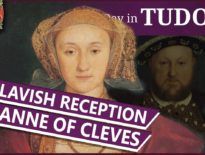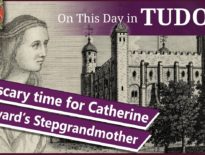On this day in Tudor history, 10th December 1591, Roman Catholic priest Edmund Gennings and Catholic Swithin Wells were executed on a scaffold set up outside Wells' house at Holborn.
Gennings had been caught celebrating mass at Wells' home by the famous Elizabethan priestfinder and torturer, Richard Topcliffe, who punished him by throwing him into the Little Ease.
Find out more about St Edmund Gennings and St Swithin Wells, and their sad ends, in today's talk.
Also on this day in Tudor history, 10th December 1541, Thomas Culpeper and Francis Dereham were executed at Tyburn. They had been found guilty of high treason for intending to do ill with Queen Catherine Howard, i..e intending to commit adultery with her, and had been sentenced to be hanged, drawn and quartered. Dereham suffered the full traitors' death, while Culpeper was beheaded. Find out more about what happened in last year’s video:
Also on this day in history:
- 1472 - Birth of Anne of Mowbray, Duchess of York and Norfolk, child bride of Richard of Shrewsbury, 1st Duke of York and one of the Princes in the Tower.
Transcript:
10 December
On this day in Tudor history, 10th December 1591, Roman Catholic priest Edmund Gennings and Catholic Swithin Wells were executed on a scaffold set up outside Wells' house at Holborn.
Let me tell you a bit more about these two Catholic martyrs, St Edmund Gennings and St Swithin Wells…
• Edmund Gennings was born in Lichfield in Staffordshire in 1566 and was the son of innkeeper and bailiff John Gennings.
• He was brought up as a Protestant, but when he was fourteen he became page to Richard Sherwood, a Catholic, and acted as a messenger between Sherwood and a man named James Layburne, a Catholic who was imprisoned in Lancaster. When Sherwood told Edmund of his plans to leave England and train for the priesthood in Rheims, Edmund decided to join him.
• In August 1583, when he was 17, Edmund was admitted to the seminary college at Douai. While studying there, he was taken ill with suspected consumption and sent home. He got as far as Le Havre but then prayed and was healed, so returned to Douai, where he was ordained in March 1590.
• Edmund was a very serious and pious young man. His biographer, Christine J Kelly, writes that “The intensity of his meditations on the responsibilities of priesthood induced a shaking of his body like a palsy that remained with him all his life, yet he spoke constantly of his hope of becoming a martyr.”
• In April 1590, just weeks after being ordained, Edmund set off for England accompanied by two other priests. Their journey was rather eventful, with them being robbed, captured for a time by Huguenots, attacked by pirates, and encountering a storm at sea, but they eventually landed at Whitby, on the Yorkshire coast. Edmund travelled on to his home at Lichfield, but on finding that only his younger brother, John, was still alive and had moved to London, he made his way to the capital. However, when he did find John, his brother didn’t want anything to do with him because of his faith.
• Edmund stayed on in the city working as a priest and on 2nd November 1591 he was in Holborn, at Swithin Wells’ house, celebrating the mass, when the famous priestfinder and torturer Richard Topcliffe found him. Topcliffe was injured in the subsequent struggle with members of the congregation, who wanted the priests to finish mass, but Edmund and his fellow priest, Polydore Plasden, surrendered peacefully and were escorted, with members of their congregation, to Newgate Prison.
• Swithin Wells had not been present at the mass, but was arrested the following day when he visited the prison in an attempt to get his wife released. Wells was a Hampshire man who had been a tutor to Henry Wriothesley, 2nd Earl of Southampton, and a school master. He’d come under investigation in the early 1580s for his Catholic sympathies, and had been forced to give up his school. He’d moved to London in 1585, where he became known for supporting priests.
He’d been imprisoned briefly in 1586, after being implicated in the Babington Plot, and was examined in 1587, but managed to avoid serious trouble until 1591.
• On 4th December 1591, Edmund, Swithin, Polydore Plasden and several others were tried at Westminster Hall, the priests for treason and the laymen for felony. Following his trial, Edmund was apparently offered a deal by Topcliffe: his life in exchange for conforming to Protestantism. Edmund refused, at which point Topcliffe had him put into the “little ease”, a tiny cell that made it impossible for Edmund to stand, sit or lie down.
• On this day in history, 10th December 1591, Edmund Gennings and Swithin Wells were drawn to Wells’ house at Holborn. There, Edmund suffered a full traitor’s death, being hanged, drawn and quartered, and Wells was hanged. While suffering, Edmund was said to have called upon St Gregory for help, upon which the executioner cried “God's wounds! His heart is in my hand and yet Gregory is in his mouth!”
• So courageous was Edmund at his execution that his brother John, who witnesses it, converted to Catholicism and wrote a biography of Edmund.
• Edmund’s fellow priest, Polydore Plasden, was also executed on this day in 1591, being hanged drawn and quartered at Tyburn. He was lucky in that he was hanged until he was dead and the rest of his punishment was carried out on his dead body.
• In October 1970, Pope Paul VI canonised Swithin, Edmund, and Polydore as three of the Forty Martyrs of England and Wales.



Leave a Reply